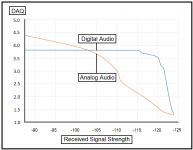Earlier in this discussion, I posted a drawing which could be named exactly the topic of this discussion: "Performance expectations when transitioning from analog to digital systems"
Virtually all the radio companies have such a drawing. I chose this one (originally from MaCom) because I think it is nicer looking than others I have seen.
I also asked the question: "If you you were buying a system and the vendor's sales team showed this to you, what would you ask them to provide in the way of proof?"
I posted the same drawing on repeater-builder and asked essentially the same question. One poster observed: "there are no scales"
Bingo. As a communications professional, wouldn't you want to see numbers associated with each axis? Numbers like delivered audio quality vs signal strength. Then you would want to know where the numbers came from. The vendor's engineers? I would rather see something from an independent third party like a university thesis or a qualified testing lab.
I have seen various versions of this graph but I have never seen one with numbers from either a manufacturer or within a technical paper or research report.
Virtually all the radio companies have such a drawing. I chose this one (originally from MaCom) because I think it is nicer looking than others I have seen.
I also asked the question: "If you you were buying a system and the vendor's sales team showed this to you, what would you ask them to provide in the way of proof?"
I posted the same drawing on repeater-builder and asked essentially the same question. One poster observed: "there are no scales"
Bingo. As a communications professional, wouldn't you want to see numbers associated with each axis? Numbers like delivered audio quality vs signal strength. Then you would want to know where the numbers came from. The vendor's engineers? I would rather see something from an independent third party like a university thesis or a qualified testing lab.
I have seen various versions of this graph but I have never seen one with numbers from either a manufacturer or within a technical paper or research report.



